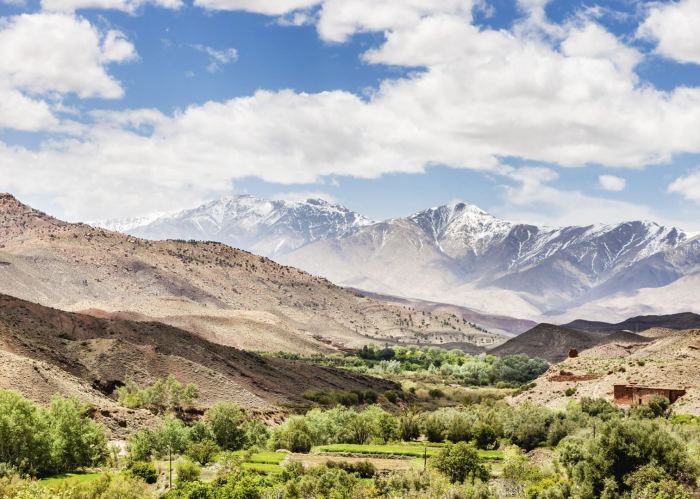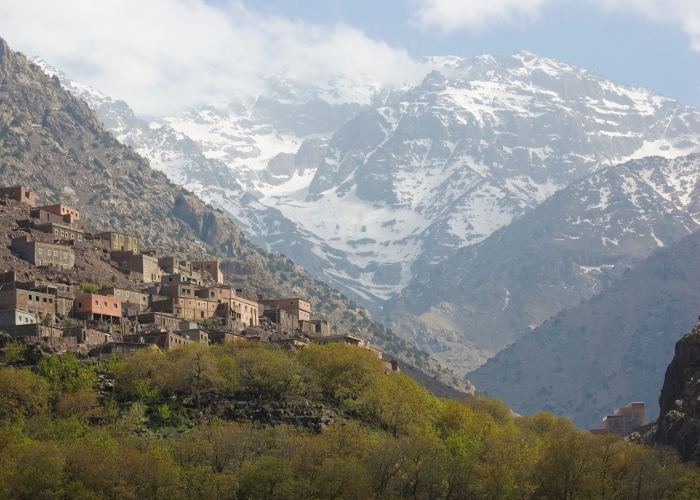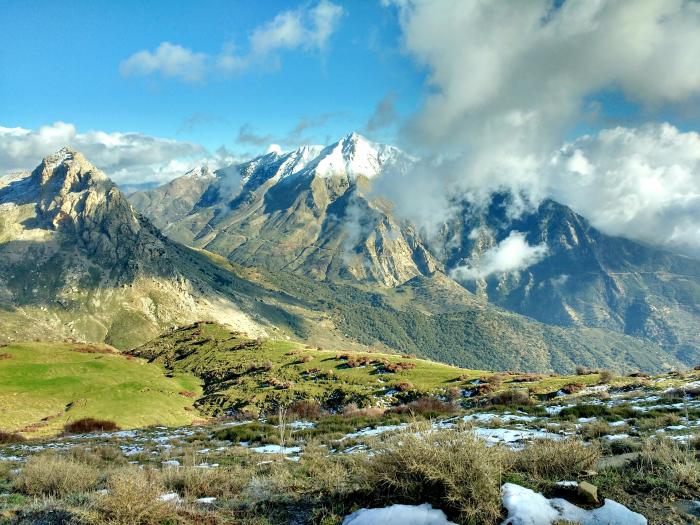The Atlas Mountains, a colossal mountain range stretching across the northwestern coast of Africa, beckon adventurers and nature enthusiasts alike. With their towering peaks, verdant valleys, and rich cultural heritage, these mountains offer an unforgettable tapestry of landscapes, ecosystems, and human history.
From the snow-capped summit of Mount Toubkal to the sun-kissed slopes of the Anti-Atlas, the Atlas Mountains present a kaleidoscope of geological wonders. Their formation, shaped by millennia of tectonic activity, has resulted in a breathtaking diversity of rock formations, fossils, and mineral deposits.
Geographic Overview

The Atlas Mountains, a majestic mountain range, are located in the northwestern part of Africa, stretching across Morocco, Algeria, and Tunisia. They are considered the backbone of North Africa, serving as a natural barrier between the Mediterranean Sea and the Sahara Desert.
The Atlas Mountains are renowned for their rugged beauty and diverse landscapes. The range extends for approximately 2,500 kilometers, with an average elevation of around 2,500 meters. The highest peak, Mount Toubkal in Morocco, rises to an impressive 4,167 meters.
Physical Characteristics
The Atlas Mountains are characterized by steep, rugged terrain, with narrow valleys and deep gorges carved by rivers and glaciers. The range is composed primarily of sedimentary rocks, including limestone, sandstone, and shale. The mountains are also home to numerous volcanic peaks, particularly in the High Atlas region of Morocco.
Geological History and Formation
The Atlas Mountains were formed as a result of the collision between the African and Eurasian tectonic plates during the late Paleozoic and early Mesozoic eras. This collision caused the Earth’s crust to buckle and fold, creating the massive mountain range.
While traversing the majestic Atlas Mountains, it’s essential to prioritize eco-friendly travel practices. Consider adopting eco-friendly travel tips such as packing light, reducing waste, and supporting local businesses. These practices not only protect the environment but also ensure the preservation of the Atlas Mountains for future generations to enjoy.
Over millions of years, the mountains have been shaped by erosion and glaciation. Glaciers carved out the deep valleys and cirques that are characteristic of the High Atlas, while erosion has created the rugged peaks and steep slopes of the Middle Atlas and Anti-Atlas ranges.
The Atlas Mountains, with their rugged peaks and deep gorges, offer a breathtaking natural spectacle. Their beauty rivals that of the historic Alnwick Castle in Northumberland, England. Its medieval architecture and stunning gardens create an enchanting setting that transports visitors to a bygone era.
Yet, the Atlas Mountains remain an awe-inspiring testament to the power of nature, their towering heights and vast expanse a reminder of the planet’s enduring majesty.
Ecological Significance

The Atlas Mountains are renowned for their exceptional biodiversity, serving as a crucial habitat for a wide array of unique flora and fauna. The region’s diverse ecosystems, ranging from lush forests to arid deserts, support a multitude of endemic species.
The mountains are home to an astonishing variety of plant life, including over 4,500 species of vascular plants. These include ancient forests of cedar, juniper, and oak, as well as a wealth of wildflowers and endemic plants found nowhere else on Earth.
Fauna of the Atlas Mountains
The Atlas Mountains also harbor a diverse array of animal life. Among the notable species are the Barbary macaque, a critically endangered primate found only in these mountains. Other notable fauna include the Atlas mountain viper, the striped hyena, and the elusive Saharan cheetah.
Importance as a Biodiversity Hotspot
The Atlas Mountains are recognized as a global biodiversity hotspot, due to their high concentration of endemic species and the threats they face. The region is particularly important for conserving the Barbary macaque, which is threatened by habitat loss and hunting.
Conservation Efforts and Challenges
Conservation efforts in the Atlas Mountains focus on protecting and restoring habitats, combating poaching, and promoting sustainable tourism. However, challenges remain, including climate change, deforestation, and overgrazing, which threaten the region’s biodiversity.
Despite these challenges, conservation organizations and local communities are working together to safeguard the ecological integrity of the Atlas Mountains. Initiatives such as protected areas, reforestation programs, and community-based conservation are helping to ensure the long-term survival of this unique and precious ecosystem.
Cultural Heritage

The Atlas Mountains hold immense historical significance for the indigenous Berber communities, who have inhabited the region for centuries. Their traditional way of life and customs have been shaped by the unique environment and rugged terrain of the mountains.
Traditional Way of Life and Customs, Atlas mountains
The Berber people of the Atlas Mountains have a rich cultural heritage that includes a deep connection to the land. They practice traditional agriculture, herding, and craftsmanship. Their villages are often located in remote and isolated areas, where they have preserved their customs and traditions over generations.
- Agriculture: The Berber people cultivate a variety of crops, including barley, wheat, and olives. They also raise livestock, such as goats, sheep, and cattle.
- Craftsmanship: The Berber people are known for their skilled craftsmanship, particularly in the production of textiles, pottery, and jewelry.
- Architecture: The traditional architecture of the Berber villages is characterized by its use of local materials, such as stone and mud. The houses are often built in a compact and terraced style, with flat roofs and small windows.
Cultural Heritage and Landmarks
The Atlas Mountains are home to a number of important cultural heritage sites, including ancient ruins, mosques, and mausoleums. These sites provide insights into the region’s rich history and cultural diversity.
- Volubilis: This ancient Roman city is located in the northern foothills of the Atlas Mountains. It was founded in the 3rd century BC and became an important center of trade and culture.
- Ksar of Ait Benhaddou: This fortified village is located in the southern Atlas Mountains. It was built in the 11th century and served as a stop on the trans-Saharan trade route.
- Kasbah of Taourirt: This kasbah is located in the city of Ouarzazate. It was built in the 19th century and served as the residence of the Pasha of Marrakech.
Tourism and Recreation

The Atlas Mountains offer a diverse range of tourist destinations and activities, attracting both domestic and international visitors. From picturesque landscapes to historic sites and vibrant cultural experiences, there’s something for everyone in this captivating mountain range.
The Atlas Mountains, a majestic mountain range spanning North Africa, are renowned for their breathtaking landscapes and rich cultural heritage. Recognized by UNESCO World Heritage Sites for their outstanding universal value, the Atlas Mountains offer a unique blend of natural and cultural wonders, from towering peaks to ancient Berber villages, making them a must-visit destination for travelers seeking adventure and immersion in a vibrant cultural tapestry.
Ecotourism is a key focus in the Atlas Mountains, with an emphasis on preserving the region’s natural beauty and cultural heritage. Sustainable practices, such as responsible waste management and promoting local businesses, are encouraged to minimize the environmental impact of tourism.
Popular Tourist Destinations
- Mount Toubkal: The highest peak in North Africa, offering stunning views and challenging trekking opportunities.
- Ourika Valley: A scenic valley with lush greenery, waterfalls, and Berber villages.
- Ait Benhaddou: A UNESCO World Heritage Site and a well-preserved fortified city.
- Dades Gorge: A dramatic canyon with towering cliffs and picturesque landscapes.
- Todra Gorge: Another stunning canyon, famous for its rock climbing and hiking trails.
Challenges and Opportunities for Tourism Development
While tourism has brought economic benefits to the region, it also presents challenges. Overcrowding, pollution, and the potential for environmental damage need to be addressed through sustainable tourism practices.
Opportunities exist to develop new ecotourism initiatives, such as guided tours that focus on local flora and fauna, cultural heritage, and responsible travel practices. Collaboration between local communities and tourism operators can ensure that the benefits of tourism are shared equitably.
Economic Importance

The Atlas Mountains support a diverse range of economic activities that contribute to the livelihoods of local communities and the regional economy.
Agriculture remains a vital industry in the Atlas Mountains, with farmers cultivating crops such as olives, almonds, and saffron. The region is also known for its livestock grazing, particularly of sheep and goats. Mining is another important economic activity, with the mountains rich in minerals such as iron ore, lead, and zinc.
Tourism and Recreation
In recent years, tourism has emerged as a major economic driver in the Atlas Mountains. The region’s stunning landscapes, cultural heritage, and outdoor recreation opportunities attract a growing number of visitors. Trekking, mountaineering, and skiing are popular activities, while cultural tours offer insights into the Berber traditions and history.
Climate Change Impacts
The Atlas Mountains, a vast and diverse mountain range, are not immune to the far-reaching effects of climate change. As global temperatures rise and weather patterns shift, the region faces numerous challenges that threaten its ecological integrity, cultural heritage, and economic stability.
One of the most significant impacts of climate change is the alteration of weather patterns. The Atlas Mountains have traditionally experienced a Mediterranean climate, characterized by hot, dry summers and mild, wet winters. However, in recent years, the region has witnessed increasingly frequent and intense heatwaves, droughts, and floods. These extreme weather events not only disrupt local ecosystems but also pose significant risks to human populations and infrastructure.
Observed Changes in Ecosystems
The changing climate has also had a profound impact on the region’s ecosystems. Rising temperatures and altered precipitation patterns have led to shifts in vegetation zones, with higher-altitude species migrating upslope in search of cooler conditions. This has resulted in the loss of biodiversity and the fragmentation of habitats, threatening the survival of many endemic species.
Furthermore, the melting of glaciers and snowpack in the Atlas Mountains has reduced water availability, particularly during the dry summer months. This has had severe consequences for both human communities and wildlife, leading to water shortages, reduced agricultural productivity, and the degradation of aquatic ecosystems.
Adaptation and Mitigation Strategies
In response to these challenges, governments, organizations, and local communities are working together to develop adaptation and mitigation strategies to address the impacts of climate change in the Atlas Mountains. These strategies include:
- Implementing water conservation measures to reduce water scarcity.
- Promoting sustainable agriculture practices to adapt to changing climate conditions.
- Protecting and restoring natural habitats to maintain biodiversity and ecosystem services.
- Investing in renewable energy sources to reduce greenhouse gas emissions.
- Raising awareness and educating local communities about climate change and its impacts.
By implementing these strategies, the Atlas Mountains can adapt to the changing climate and continue to provide vital ecosystem services for future generations.
Summary: Atlas Mountains

As we bid farewell to the Atlas Mountains, we leave with a profound appreciation for their ecological, cultural, and economic significance. These mountains stand as a testament to the indomitable spirit of the Berber people, the resilience of nature, and the importance of sustainable development in harmony with our planet.
Question & Answer Hub
Where are the Atlas Mountains located?
The Atlas Mountains stretch across the northwestern coast of Africa, primarily in Morocco, Algeria, and Tunisia.
What is the highest peak in the Atlas Mountains?
Mount Toubkal, located in Morocco, is the highest peak in the Atlas Mountains, reaching an elevation of 4,167 meters (13,665 feet).
What is the geological history of the Atlas Mountains?
The Atlas Mountains were formed during the collision of the African and Eurasian tectonic plates, resulting in the uplift and folding of the Earth’s crust.
What are the major economic activities in the Atlas Mountains?
Agriculture, mining, and tourism are the primary economic activities in the Atlas Mountains.